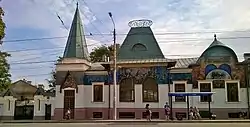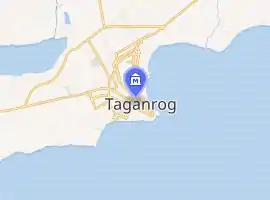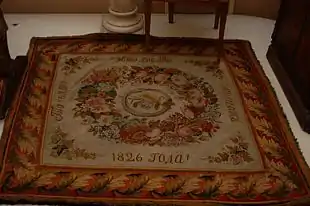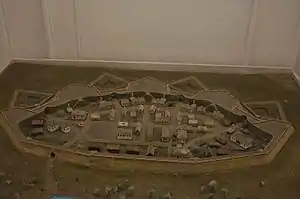Taganrog Museum of Architecture and Urbanism
Taganrog Museum of Architecture and Urbanism is a museum in the city of Taganrog, Russia. The building was designed by the architect Fyodor Schechtel's studio.
Музей «Градостроительство и быт города Таганрога» | |
 Taganrog Museum of Architecture and Urbanism | |

| |
| Established | November 3, 1981[1] |
|---|---|
| Location | Ulitsa Frunze 80, Taganrog |
| Type | Museum of local history |
| Director | Mrs. Marianna Yevgenievna Grigoryan (Russian: Григорян, Марианна Евгеньевна) |
| Architect | Fyodor Schechtel's studio |
| Public transit access | "The Palace of Culture of Combine-Builders" tram and bus stop |
The building
The Taganrog Museum of Architecture and Urbanism is located in the former house of Sharonov, which represents a scaled-down model of the Moscow Yaroslavsky railway station and remains one of the best examples of Art Nouveau style architecture in Taganrog. The building was constructed in 1912 upon a project designed by Fyodor Schechtel's architectural studio. It is in the federal list of cultural heritage sites[2].
The main value of the building is in its ceramic panels produced by the world-known Abramtsevo workshop based on sketches by such renowned artists as Nicholas Roerich, Mikhail Vrubel and Viktor Vasnetsov. Impressive majolica tiles presenting a variety of subjects cover the whole top of the building's front facade: "The Girl with a Flower", "Battle", "The Departure of Ladya Boats" and "Mermaid".
Of special interest is the entrance gate adorned with faceted lion masks designed by Mikhail Vrubel.
In 1977 the building was given to the Taganrog Arts & Culture Council for opening a branch of the Museum of local lore & history.
Museum collection
The new museum was established in 1981 to focus on the development of Taganrog's town-planning, historical buildings and its residents' modes of life from 17th century up to present times. Today it is part of Taganrog State Museum-Preserve of Literature, History and Architecture. It has an eleven-hall exposition that chronologically shows the architectural history of Taganrog and the life of its inhabitants from the city's foundation until nowadays. In addition to old postcards, photographs and maps, it showcases unique samples of furniture and arts and crafts.
The exhibition halls present objects from the Taganrog Museum Reserve, artworks of local artists, photography, modern interactive features, etc.
June 25, 2019 the museum was reopened with a new updated exhibit entitled "A Time-Lapse Portrait of the City"[3].
Gallery
 Отплытие ладей by Nicholas Roerich from the majolica panel
Отплытие ладей by Nicholas Roerich from the majolica panel Carpet on which Elizabeth Alexeievna (Louise of Baden) stood to pray after death of Alexander I of Russia from Alexander I Palace. Now in the collection of Taganrog City Development Museum. The inscription on the carpet reads "Blessed Be the Place where You Prayed. 1826!"
Carpet on which Elizabeth Alexeievna (Louise of Baden) stood to pray after death of Alexander I of Russia from Alexander I Palace. Now in the collection of Taganrog City Development Museum. The inscription on the carpet reads "Blessed Be the Place where You Prayed. 1826!" The model of the Taganrog Fortress from the collection of the Taganrog City Architectural Development Museum
The model of the Taganrog Fortress from the collection of the Taganrog City Architectural Development Museum Photograph of the original plan of the Pyotr Papkov's mansion in Taganrog, later to become the Alexander I Palace
Photograph of the original plan of the Pyotr Papkov's mansion in Taganrog, later to become the Alexander I Palace
References
- Taganrog Encyclopedia (Энциклопедия Таганрога), 2nd edition, Taganrog, 2003
External links
| Wikimedia Commons has media related to Sharonov House. |


